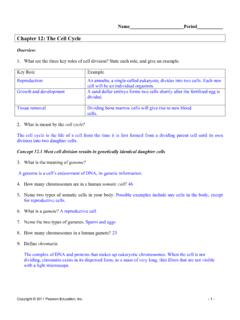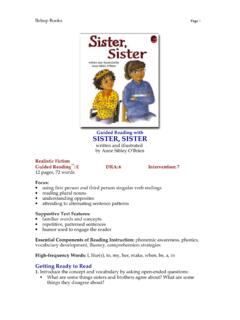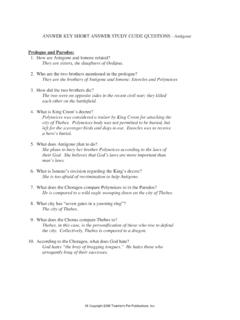Transcription of Chapter 13: Meiosis and Sexual Life Cycles - Weebly
1 Copyright 2011 Pearson Education, Inc. -1- Name_____Period_____ Chapter 13: Meiosis and Sexual life Cycles Concept Offspring acquire genes from parents by inheriting chromosomes 1. Let s begin with a review of several terms that you may already know. Define: gene: A discrete unit of hereditary information consisting of a specific nucleotide sequence in DNA (or RNA, in some viruses) locus: A specific place along the length of a chromosome where a given gene is located gamete: A haploid reproductive cell, such as an egg or sperm. Gametes unite during Sexual reproduction to produce a diploid zygote.
2 Male gamete: Sperm female gamete: Eggs asexual reproduction: The generation of offspring from a single parent that occurs without the fusion of gametes (by budding, division of a single cell, or division of the entire organism into two or more parts). In most cases, the offspring are genetically identical to the parent. Sexual reproduction: A type of reproduction in which two parents give rise to offspring that have unique combinations of genes inherited from both parents via the gametes 2. How many chromosomes are in human cells?
3 What is a chromosome? There are 46 chromosomes in human somatic cells. A chromosome is a cellular structure carrying genetic material, found in the nucleus of eukaryotic cells. Each chromosome consists of one very long DNA molecule and associated proteins. 3. Which type of reproduction will result in genetically identical offspring? Asexual reproduction Concept Fertilization and Meiosis alternate in Sexual life Cycles 4. What is a somatic cell? Give examples of two human somatic cell types. A somatic cell is any cell in a multicellular organism except a sperm or egg or their precursors.
4 Examples may vary but could include bone cells, skin cells, blood cells, etc. Copyright 2011 Pearson Education, Inc. -2- 5. How does a somatic cell compare to a gamete in terms of chromosome number? Unlike somatic cells, gametes contain a single set of chromosomes. Such cells are called haploid cells, and each has a haploid number of chromosomes (n). For humans, the haploid number is 23. Description # in Human Cells Sex chromosome A chromosome responsible for determining the sex of an individual 1 Autosome A chromosome that is not directly involved in determining sex; not a sex chromosome 22 7.
5 What is a karyotype? How is it prepared? When images of the chromosomes are arranged in pairs, starting with the longest chromosomes, the resulting ordered display is called a karyotype. Karyotypes are prepared from isolated somatic cells, which are treated with a drug to stimulate mitosis and then grown in culture for several days. Cells arrested in metaphase, when chromosomes are most highly condensed, are stained and then viewed with a microscope equipped with a digital camera. A photograph of the chromosomes is displayed on a computer monitor, and the images of the chromosomes are arranged into pairs according to their appearance.
6 8. What are three things that can be determined from a karyotype? (Study the Research Method, Figure , in your text carefully for this information.) Size of the chromosome, position of the centromere, and pattern of the stained bands 9. Explain what is meant by homologous chromosomes. A pair of chromosomes of the same length, centromere position, and staining pattern 10. Cells that have only one of each homologous pair are said to be haploid, a condition that is represented by n. Cells that have two of each homologous pair are said to be diploid or 2n.
7 For each of the following, is the cell haploid or diploid? liver cell diploid gamete haploid egg cell haploid zygote diploid skin cell diploid sperm haploid somatic cell diploid sex cell haploid 11. The muscle cells of a dog have 78 chromosomes. Fill in the correct chromosome number in a bone cell 78, sperm 39, haploid cell 39, somatic cell 78, and zygote 78. Copyright 2011 Pearson Education, Inc. -3- 12. In the cell at right, the chromosomes are shaded in two colors to represent the parent of origin.
8 On this sketch, label the following: See page 251 of your text for the labeled figure. a. sister chromatids b. homologous chromosomes c. centromere d. replicated chromosome e. maternal chromosomes 13. How many chromosomes does the cell above have? 6 How many homologous pairs? 3 How many chromatids? 12 Is this cell haploid or diploid? Diploid 14. Where are the gametes of an animal produced? Be specific as to male and female gametes. The only cells of the human body not produced by mitosis are the gametes, which develop from specialized cells called germ cells in the gonads ovaries in females and testes in males.
9 15. By what process are gametes produced? Meiosis 16. What is another term for a fertilized egg? Zygote What is the chromosome number of the fertilized egg? (Answer this in general terms, haploid, n, or diploid, 2n). Diploid, 2n 17. What is the purpose of Meiosis ? Meiosis is a modified type of cell division in sexually reproducing organisms consisting of two rounds of cell division but only one round of DNA replication. It results in cells with half the number of chromosome sets as the original cell, producing gametes, and introducing genetic variability.
10 18. Study Figure in your text. You will see that plants have a life cycle that involves spores, which form as a result of Meiosis , so these spores are haploid. Notice also that both haploid and diploid cells can divide by mitosis. However, Meiosis always begins with cells that are diploid , and as a result of Meiosis , daughter cells are formed that are always haploid. These cells can be gametes (in animals) or spores (in plants). 19. Your study of plants this year will include knowing that they exhibit alternation of generations. What does this mean?











